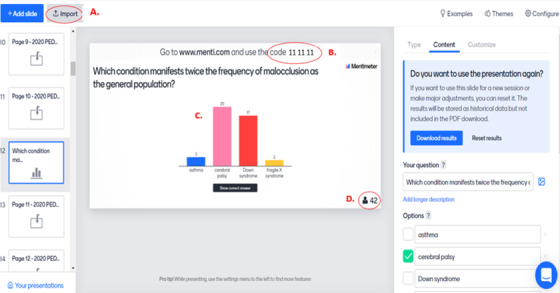1. PROBLEM
While doors to dental and hygiene institutions close, the minds and educational pursuits of students and residents do not. Being removed from the standard learning environment due to the COVID‐19 pandemic posed unprecedented challenges to the educational infrastructure. Virtual classrooms and webinars became the mainstay of conveying didactic information during the shelter‐in‐place mandate. Several institutions created collaborative webinar sessions using virtual educational systems. Attendees used digital devices to access information during live electronic presentations.
The questions become: How effective is electronic conveyance of information measured in real time? And, can information be successfully conveyed to learners at different levels of education? Assessing real‐time learner understanding typically relies on facial expression and queries during live classroom interaction, yet virtual education presents barriers to modulating content delivery. Mubayrik 1 surveyed dental graduates who participated in distance learning and described a crucial limitation as difficulty in measuring outcomes and recommended adaptive learning take advantage of technology. The survey noted feedback between educator and student played a significant role in learner understanding. Learning components not yet examined are those of constructive feedback during and value of distance learning.
2. SOLUTION
Four pediatric dentistry residency programs across 3 states and 2 time zones participated in a Zoom (Zoom Video Communications, San Jose, CA, USA) virtual presentation incorporating a Microsoft PowerPoint (Microsoft Corporation, Redmond, WA, USA) lecture. Participants were at varying academic progress within and across their 2‐year postdoctoral programs. Mentimeter (Mentimeter, Stockholm, Sweden, www.mentimeter.com) enabled embedding multiple‐choice quiz questions during the presentation to assess information knowledge and a series of multiple‐choice quiz questions following the presentation to assess information retention. Fifty pediatric dental residents were able to participate in the quizzes that provided real‐time feedback yet kept responses anonymous.
Mentimeter is a cloud‐based package that allows presenters and recipients to interact in real time during an uploaded presentation by incorporating various formats of quiz questions and polling queries (Figure 1). Response anonymity eliminates intimidation while fostering participation for small groups, whereas for larger programs the data collected assists presenters in restructuring real‐time content delivery for improved efficacy. Results of the presentation quiz outcomes were discussed in real‐time and participants could ask questions using either electronic device microphone or chat box within the presentation. Multiple faculty from all programs contributed to the discussion.
FIGURE 1.

Mentimeter interface sample. (A) Tab to import presentation into Mentimeter package which displays imported slides along left border with ability to add inquiry. (B) Autogenerated participation code specific for uploaded presentation (data may be harvested, and presentations can be reused with or without previously collected data points). (C) Sample of multiple‐choice bar chart display (Several choices of options to display outcomes for each inquiry) of anonymously reported responses (responses can either be viewed in real time or presenter can choose “hide responses” to display synchronously). (D) Indicator for number of responses registered for each inquiry
3. RESULTS
Data recorded during the multilocation interactive session showed participants answered 61% of 13 questions queried during the presentation correctly, and 83% of 7 questions following the presentation correctly. One final question inquired if participants felt they learned from the discussion and real‐time feedback via incorporated quiz questions and participating pediatric dentistry residents reported a positive learning experience. While audience engagement software has successfully been useful in academic settings, the current application was unique in promoting active learning among different levels of learners in multiple curricular program designs. Incorporating multiple technologies is time‐consuming yet resulted in positive outcomes. For future endeavors, constructing parallel pre‐evaluations and postevaluations may enhance relevant learning outcomes for both presenter and participants. Involving multiple institutions reduced workload of individual programs during the COVID‐19 educational dilemma.
Patterson KK, Ritwik P, Kerins CA, Adewumi A. Real‐time measurement for effectiveness of novel educational endeavors during the COVID‐19 pandemic. J Dent Educ. 2021;85(Suppl. 1):1020–1021. 10.1002/jdd.12363
REFERENCE
- 1. Mubayrik HFB. Exploring adult learners’ viewpoints and motivation regarding distance learning in medical education. Adv Med Educ Pract. 2020;11:139‐146. [DOI] [PMC free article] [PubMed] [Google Scholar]


